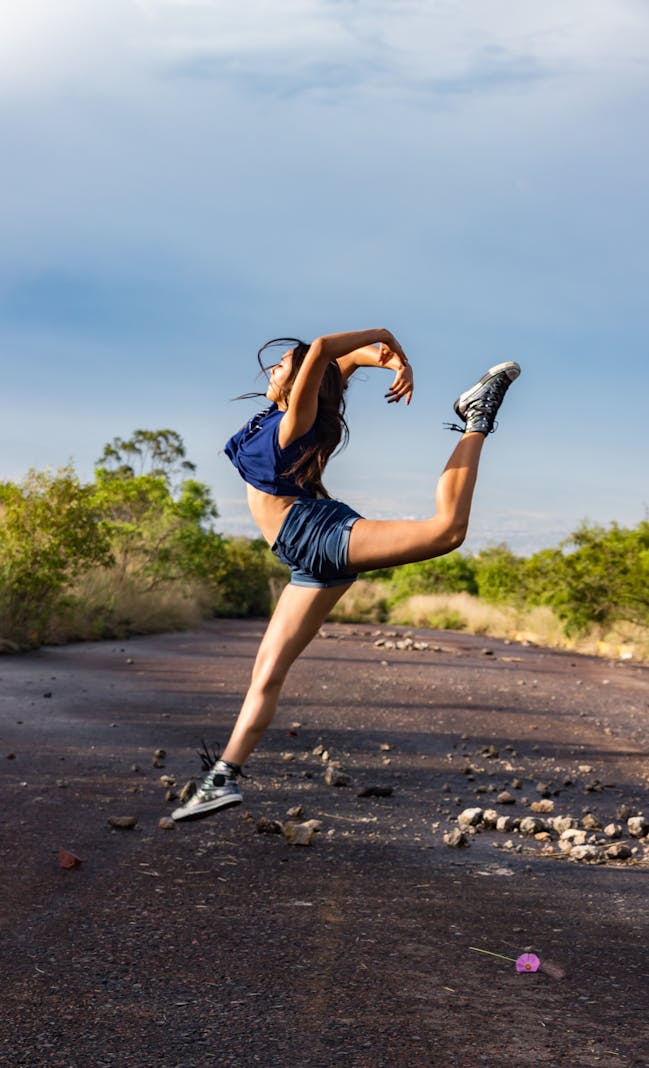Natarajasana

The Hindi Trimurti of Brahma, Vishnu, and Shiva, and the Tridevi of Saraswati, Lakshmi, and Parvati, are each “Triple Deities”; in other words the male and female avatars of ultimate sanctity. Together, they are responsible for creation, conservation, and destruction in an unending pattern, and can be understood as a complex whole or in separate incarnations. Nataraj, another name for Shiva, is known as the “Lord of the Dance,” and represents all movement in the universe, with the ultimate purpose of releasing one from the illusion of separation from the rest of creation. Sounds similar to the aim of yoga, yes? The pose Natarajasana , or Lord of the Dance Pose, challenges us to lose our illusions about our level of fitness, but also our misconceptions about our abilities and goals. This is not an easy pose, but one that rewards us with greater flexibility, both in our bodies and in our minds and souls.
To first practice this pose, find a wall to use as a prop. Face the wall, and bring your balance to your right foot. Choose a spot at the wall for a drishti or focal point, and raise your right hand so that it balances itself on the wall. Inhale and straighten your spine. Then bend the left knee, bringing the foot up behind you. Reach your left hand around the back of your body to grab your foot. Your knee may want to splay out away from your torso, but try to avoid this. Balance, using as little of the wall as you can, and stay for a few breaths. On an exhale, release the left foot and bring it to the ground. Straighten your back, bring your weight to the left leg, and practice the same movements on the other side.
Once you have the basic mechanics of the pose in your muscle memory, you can try bending your back and leaning forward on each side. Again, keep the knees from splaying out and keep your shoulders within their sockets. Note the resemblance of this pose to the statues of Nataraj, who gave the name to this pose.
Another way to practice this pose is to first move into Warrior, or Virabhadrasana III, otherwise known as T pose. Bringing your weight into the right foot, lean forward and make a ‘T” with your arms, torso, and left leg bisecting the standing right leg. After a moment here, bend the upraised leg at the knee and bring the arm around to catch the foot, coming up into Natarajasana.
Be sure to keep the long spine and straight standing leg. If working without the prop means that your shape lacks alignment, you need to build up the strength and flexibility required by the pose before moving away from the wall.
For an advanced version of this pose, try bringing both arms overhead and then moving into a full backbend, catching the foot from above. Of course, most of us don’t have the spinal flexibility to be able to bend in this way, but the full pose is quite beautiful to see.
Disclaimer: I am not a physician, and the above is not intended as medical advice. Always talk to your doctor before beginning any exercise program.
To first practice this pose, find a wall to use as a prop. Face the wall, and bring your balance to your right foot. Choose a spot at the wall for a drishti or focal point, and raise your right hand so that it balances itself on the wall. Inhale and straighten your spine. Then bend the left knee, bringing the foot up behind you. Reach your left hand around the back of your body to grab your foot. Your knee may want to splay out away from your torso, but try to avoid this. Balance, using as little of the wall as you can, and stay for a few breaths. On an exhale, release the left foot and bring it to the ground. Straighten your back, bring your weight to the left leg, and practice the same movements on the other side.
Once you have the basic mechanics of the pose in your muscle memory, you can try bending your back and leaning forward on each side. Again, keep the knees from splaying out and keep your shoulders within their sockets. Note the resemblance of this pose to the statues of Nataraj, who gave the name to this pose.
Another way to practice this pose is to first move into Warrior, or Virabhadrasana III, otherwise known as T pose. Bringing your weight into the right foot, lean forward and make a ‘T” with your arms, torso, and left leg bisecting the standing right leg. After a moment here, bend the upraised leg at the knee and bring the arm around to catch the foot, coming up into Natarajasana.
Be sure to keep the long spine and straight standing leg. If working without the prop means that your shape lacks alignment, you need to build up the strength and flexibility required by the pose before moving away from the wall.
For an advanced version of this pose, try bringing both arms overhead and then moving into a full backbend, catching the foot from above. Of course, most of us don’t have the spinal flexibility to be able to bend in this way, but the full pose is quite beautiful to see.
Disclaimer: I am not a physician, and the above is not intended as medical advice. Always talk to your doctor before beginning any exercise program.

Related Articles
Editor's Picks Articles
Top Ten Articles
Previous Features
Site Map
Content copyright © 2023 by Korie Beth Brown. All rights reserved.
This content was written by Korie Beth Brown. If you wish to use this content in any manner, you need written permission. Contact Korie Beth Brown for details.







